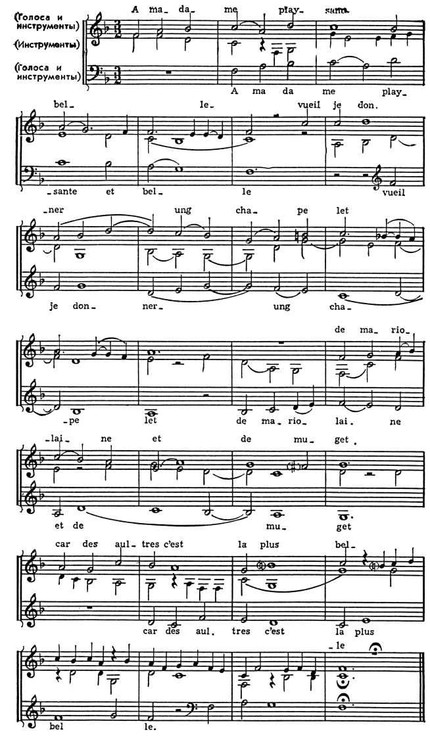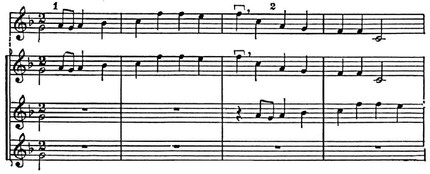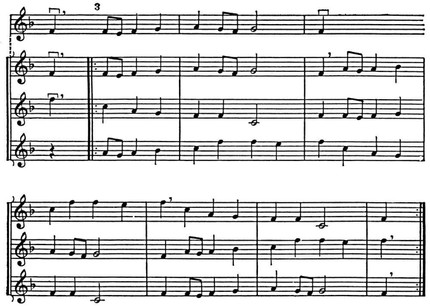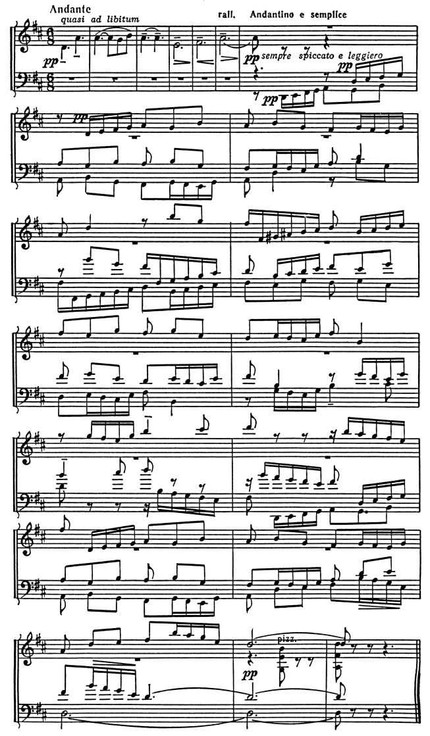
Canon |
from the Greek kanon – norm, rule
1) In Dr. Greece, a device for studying and demonstrating the ratio of tones formed by dec. parts of a vibrating string; from the 2nd century received the name monochord. K. also called the very numerical system of interval ratios established with the help of a monochord, in subsequent times – some muses. tools, ch. arr. related to the monochord in terms of device (for example, the psalterium), tool parts.
2) In Byzantium. hymnography polystrophic product. complex lit. designs. K. appeared in the 1st floor. 8th c. Among the authors of the earliest k. are Andrei of Crete, John of Damascus, and Cosmas of Jerusalem (Mayum), Syrians by origin. There are incomplete K., so-called. two-songs, three-songs and four-songs. Complete K. consisted of 9 songs, but the 2nd soon fell into disuse. Cosmas of Jerusalem (Mayumsky) no longer used it, although he retained the nomenclature of the nine odes.
In this form, K. exists to this day. The 1st stanza of each K. song is irmos, the following (usually 4-6) are called. troparia. The initial letters of the stanzas formed an acrostic, indicating the name of the author and the idea of the work. Churches arose in the conditions of the empire’s struggle with icon veneration and represented “rough and ardent songs” (J. Pitra) of celebrations. character, directed against the tyranny of the iconoclast emperors. K. was intended for singing by the people, and this determined the architectonics of his text and the nature of the music. Thematic The material for the irmos was the songs of the Hebrew. poetry and less often actually Christian, in which the patronage of God to the people in his struggle against tyrants was glorified. The troparia praised the courage and suffering of the fighters against tyranny.
The composer (who was also the author of the text) had to endure the irmos syllabic in all stanzas of the song, so that the muses. the accents everywhere corresponded to the prosody of the verse. The melody itself had to be uncomplicated and emotionally expressive. There was a rule for composing K.: “If anyone wants to write K., then he must first voice the irmos, then ascribe troparia with the same syllabic and consonant with the irmos, preserving the idea” (8th century). From the 9th century most hymnographers composed K., using the irmoses of John of Damascus and Cosmas of Mayum as a model. K.’s tunes were subject to the system of osmosis.
In Russian church, the vowel affiliation of K. was preserved, but due to a violation in the glory. translation of the Greek syllabics. only irmoses could sing the original, while troparia had to be read. The exception is the Paschal K. – in singing books there are samples of it, notated from beginning to end.
In the 2nd floor. 15th c. a new one appeared, rus. style K. Its founder was a monk from Athos Pachomius Logofet (or Pachomius Serb), who wrote approx. 20 K., dedicated to Russian. holidays and saints. The language of the canons of Pachomius was distinguished by an ornate, pompous style. The writing style of Pachomius was imitated by Markell Beardless, Hermogenes, later patriarch, and other hymnographers of the 16th century.
3) Since the Middle Ages, a form of polyphonic music based on strict imitation, holding all sections of the proposta in the rispost or risposts. Until the 17th and 18th centuries bore the name fugue. The defining features of K. are the number of votes, the distance and interval between their introductions, the ratio of proposta and risposta. The most common are 2- and 3-voice K., however, there are also K. for 4-5 voices. K. known from the history of music with a large number of voices represent combinations of several simple K.
The most common entry interval is the prima or octave (this interval is used in the earliest examples of K.). This is followed by a fifth and a fourth; other intervals are used less frequently, because while maintaining the tonality, they cause interval changes in the theme (the transformation of large seconds into small seconds in it and vice versa). In K. for 3 or more voices, the intervals for the entry of voices may be different.
The simplest ratio of votes in K. is the exact holding of a proposta in a rispost or risposts. One of the types of K. is formed “in direct motion” (Latin canon per motum rectum). K. can also be attributed to this type in an increase (canon per augmentationem), in a decrease (canon per diminutionem), with decomp. metric registration of votes (“mensural”, or “proportional”, K.). In the first two of these types, K. risposta or risposta fully correspond to proposta in melodic terms. pattern and ratio of durations, however, the absolute duration of each of the tones in them is respectively increased or reduced in several. times (double, triple increase, etc.). “Mensural”, or “proportional”, K. is associated by origin with mensural notation, in which two-part (imperfecte) and three-part (perfecte) crushing of the same durations was allowed.
In the past, especially in the era of the dominance of polyphony, K. with a more complex ratio of voices were also used – in circulation (canon per motum contrarium, all ‘inverse), in countermovement (canon cancrisans), and mirror-crab. K. in circulation is characterized by the fact that the proposta is carried out in the risposta or rispostas in an inverted form, that is, each ascending interval of the proposta corresponds to the same descending interval in the number of steps in the risposta and vice versa (see Inversion of the Theme). In the traditional K., the theme in the rispost passes in a “reverse motion” compared to the proposta, from the last sound to the first. Mirror-crustaceous K. combines signs of K. in circulation and crustacean.
According to the structure, there are two basic. type K. – K., ending simultaneously in all voices, and K. with non-simultaneous completion of the sound of voices. In the first case, will conclude. cadence, the imitation warehouse is broken, in the second it is preserved to the end, and the voices fall silent in the same sequence in which they entered. A case is possible when, in the process of its deployment, the voices of a K. are brought to its beginning, so that it can be repeated an arbitrary number of times, forming the so-called. endless canon.
There are also a number of special types of canons. K. with free voices, or incomplete, mixed K., is a combination of K. in 2, 3, etc. voices with free, non-imitative development in other voices. K. on two, three topics or more (double, triple, etc.) begins with the simultaneous entry of two, three or more proposts, followed by the entry of the corresponding number of risposts. There are also K., moving along the sequence (canonical sequence), circular, or spiral, K. (canon per tonos), in which the theme modulates, so that it gradually passes through all the keys of the fifth circle.
In the past, only proposta was recorded in K., at the beginning of which, with special characters or special. the explanation indicated when, in what sequence of votes, at what intervals and in what form the risposts should enter. For example, in Dufay’s Mass “Se la ay pole” it is written: “Cresut in triplo et in duplo et pu jacet”, which means: “Grows triple and double and as it lies.” The word “K.” and denotes a similar indication; only in the course of time did it become the name of the form itself. In the department cases of proposta was discharged without c.-l. indications of the conditions for entering the rispost – they had to be determined, “guessed” by the performer. In such cases, the so-called. enigmatic canon, which allowed several different. variants of the entry of the risposta, naz. polymorphic.
Some more complex and specific ones were also used. varieties of K. – K., in which only dec. parts of the proposta, K. with the construction of the risposta from the sounds of the proposta, arranged in descending order of durations, etc.
The earliest examples of 2-voice chimes date back to the 12th century, and 3-voice ones date back to the 13th century. The “Summer Canon” from Reading Abbey in England dates from about 1300, indicating a high culture of imitative polyphony. By 1400 (at the end of the ars nova era) K. penetrated into cult music. At the beginning of the 15th century there are the first K. with free voices, K. in an increase.
The Dutch J. Ciconia and G. Dufay use the canons in motets, canzones, and sometimes in masses. In the work of J. Okegem, J. Obrecht, Josquin Despres and their contemporaries, canonical. technology reaches a very high level.

X. de Lantins. Song 15th century
Canonical technique was an important element of the muses. creativity 2nd floor. 15th c. and greatly contributed to the development of contrapuntal. skill. Creative. music comprehension. possibilities diff. forms of canons led, in particular, to the creation of a set of canons. mass dec. authors (with the title Missa ad fugam). At this time, the subsequently almost disappeared form of the so-called was often used. proportional canon, where the theme in the risposta changes in comparison with the risposta.
The use of k. in large forms in the 15th century. testifies to the full awareness of its potentialities – with the help of K., the unity of expressiveness of all voices was achieved. Later, the canonical the technique of the Dutch did not receive further development. To. very seldom was applied as independent. form, somewhat more often – as part of an imitation form (Palestrina, O. Lasso, T. L. de Victoria). Nevertheless, K. contributed to the ladotonal centralization, strengthening the significance of fourth-quint real and tonal responses in free imitations. The earliest known definition of K. refers to con. 15th c. (R. de Pareja, “Musica practica”, 1482).

Josquin Despres. Agnus Dei secundum from the mass “L’Homme arme super voces”.
In the 16th century canonical technique begins to be covered in textbooks (G. Zarlino). However, k. is also denoted by the term fuga and opposes the concept of imitatione, which denoted the inconsistent use of imitations, that is, free imitation. The differentiation of the concepts of fugue and canon begins only in the 2nd half. 17th century In the Baroque era, interest in K. somewhat increases; K. penetrates instr. music, becomes (especially in Germany) an indicator of composer’s skill, having reached the greatest peak in the work of J.S. Bach (canonical processing of cantus firmus, parts of sonatas and masses, Goldberg variations, “Musical offering”). In large forms, as in most fugues of the era of Bach and subsequent times, canonical. the technique is most often used in stretches; K. acts here as a concentrated display of the theme-image, devoid of other counterpoints in general stretches.


А. Кальдара. “Let’s go to the caocia.” 18 в.
Compared with J. S. Bach, the Viennese classics use K. much less frequently. Composers of the 19th century R. Schumann and I. Brahms repeatedly turned to the form of k. A certain interest in K. is characteristic of the 20th century to an even greater extent. (M. Reger, G. Mahler). P. Hindemith and B. Bartok use canonical forms in connection with the desire for the dominance of the rational principle, often in connection with constructivist ideas.
Rus. classical composers did not show much interest in k. as an independent form. works, but often used varieties of canonical. imitations in stretches of fugues or polyphonic. variations (M. I. Glinka – fugue from the introduction to “Ivan Susanin”; P. I. Tchaikovsky – 3rd part of the 2nd quartet). K., incl. endless, often used either as a means of braking, emphasizing the level of tension reached (Glinka – the quartet “What a wonderful moment” from the 1st picture of the 1st act of “Ruslan and Lyudmila”; Tchaikovsky – the duet “Enemies” from the 2nd picture 2- th action of “Eugene Onegin”; Mussorgsky – chorus “Guide” from “Boris Godunov”), or to characterize the stability and “universality” of mood (A. P. Borodin – Nocturne from the 2nd quartet; A. K. Glazunov – 1 -I and 2nd parts of the 5th symphony; S. V. Rachmaninov – slow part of the 1st symphony), or in the form of canonical. sequences, as well as in K. with the change of one type of K. to another, as a means of dynamic. increase (A. K. Glazunov – 3rd part of the 4th symphony; S. I. Taneev – 3rd part of the cantata “John of Damascus”). Examples from the 2nd quartet of Borodin and the 1st symphony of Rachmaninov also demonstrate the k. used by these composers with changing conditions of imitation. Russian traditions. classics continued in the works of owls. composers.
N. Ya. Myaskovsky and D. D. Shostakovich have a canon. forms have found quite wide application (Myaskovsky – the 1st part of the 24th and the finale of the 27th symphonies, the 2nd part of the quartet No. 3; Shostakovich – the stretches of the fugues in the piano cycle “24 preludes and fugues” op. 87, 1- I part of the 5th symphony, etc.).

N. Ya. Myaskovsky 3rd quartet, part 2, 3rd variation.
Canonical forms not only show great flexibility, allowing them to be used in music of various styles, but are also extremely rich in varieties. Rus. and owls. Researchers (S. I. Taneev, S. S. Bogatyrev) contributed major works on the theory of k.
References: 1) Yablonsky V., Pachomius the Serb and his hagiographic writings, SPB, 1908, M. Skaballanovich, Tolkovy typikon, vol. 2, K., 1913; Ritra J. V., Analecta sacra spicilegio Solesmensi, parata, t. 1, Paris, 1876; Wellesz E., A history of Byzantine music and hymnography, Oxf., 1949, 1961.
2) Taneev S., Doctrine of the Canon, M., 1929; Bogatyrev S., Double canon, M. – L., 1947; Skrebkov S., Textbook of polyphony, M., 1951, 1965, Protopopov V., History of polyphony. Russian classical and Soviet music, M., 1962; his, History of polyphony in its most important phenomena. Western European classics, M., 1965; Klauwell, O.A., Die historische Entwicklung des musikalischen Kanons, Lpz., 1875 (Diss); Jöde Fr., Der Kanon, Bd 1-3, Wolfenbüttel, 1926; his own, Vom Geist und Gesicht des Kanons in der Kunst Bachs?, Wolfenbüttel, 1926; Mies R., Der Kanon im mehrstzigen klassischen Werk, “ZfMw”, Jahrg. VIII, 1925/26; Feininger LK, Die Frühgeschichte des Kanons bis Josquin des Prez (um 1500), Emsdetten in W., 1937; Robbins RH, Beiträge zur Geschichte des Kontrapunkts von Zarlino bis Schütz, B., 1938 (Diss); Blankenburg W., Die Bedeutung des Kanons in Bachs Werk, “Bericht über die wissenschaftliche Bachtagung Leipzig, 1950”, Lpz., 1951; Walt JJ van der, Die Kanongestaltung im Werk Palestrinas, Köln, 1956 (Diss.).
H. D. Uspensky, T. P. Muller



